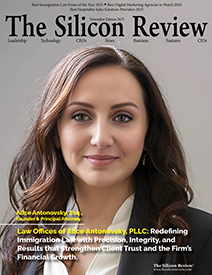FactualVR – Improving Justice through Virtual Reality
The Silicon Review
![]()
“Building a virtual reality platform to help law enforcement and prosecutors to accurately replicate and communicate the facts around a crime scene.”
Rapid growth in Virtual Reality (VR) in recent years has stemmed from new research and hardware development for the use in Augmented Reality. Used as a tool by investigators, examiners, and remote specialists, they have a wide range of potential uses to both aid examiners on-site and facilitate collaborative efforts remotely. AR and VR technology is finding its way into all sorts of existing industries, and now the groundbreaking technology is helping law enforcement solve crimes.
FactualVR is one such firm thatprovides the ability to annotate and collaborate throughout the end-to-end process – from the crime scene to the courtroom. The company’s solution allows capturing and reproducing crime scenes using Virtual Reality technologies. The firm has developed a complete software platform incorporating multiple Patented and Patent Pending technologies. It provides a multi-user system that allows two users, located at distant locations, to collaborate with each other using immersive Virtual reality (VR) and Augmented Reality (AR) interfaces. They also provide a VR environment for an expert/supervisor user at the central location.
Main Objective
FactualVR is a virtual reality platform to help law enforcement, prosecutors, and defense attorneys to accurately replicate and communicate the facts around a crime or accident scene.
Primary Perception
To improve justice and to allow anyone to inspect a crime scene, using Virtual Reality.
Astonishing technologies of FactualVR
The FactualVR platform provides the following capabilities:
Compile data from VR sensors (cameras, scanners, etc)
FactualVR’s software is designed to import and process data from multiple sensors, including laser scanners, videos, images, audio, documents, etc. The system can handle multiple formats for point clouds and meshes, as well as multiple formats for images and videos, including 360° imagery and binaural audio.
Integrate VR data into a virtual recreation of the scene
Once the raw data is imported, the system will process the input and produce a real-size immersive representation of the scene, including the scene environment and individual interactive objects for each piece of evidence that the user might want to include.
Visualize and navigate the virtual crime scene
Users are then immersed in the virtual space to observe and explore the scene – like if they were there. The VR system provides a full sense of “Presence.” It allows users to walk around to see the scene, as well as the collected evidence, from every desired point of view.
Annotate and collaborate through the process
The multi-user capability enables remote users to meet at the virtual scene to add information in the form of verbal and visual annotations, as well as communicate and collaborate with each other during the process. Users can record enactments and simulate the potential sequence of events to tell the story.
FactualVR’sHypertunnel
Hypertunnel enables field technicians to summon an expert for side-by-side guidance and supervision through a shared virtual environment. The deployment of Hypertunnel is expected to accrue numerous benefits to industry, the U.S. economy, and society as a whole. With respect to the industry, there are a variety of commercial sectors and customers that will benefit from the use of Hypertunnel, including electrical utility companies, oil & gas extraction equipment end-users, medical practitioners as well as any industry with significant capital infrastructure. These industries will benefit from repairs and upgrades being more effectively executed fewer errors and equipment malfunctions, and less equipment downtime resulting from field technician mistakes.
Hypertunnel will enable cost savings from leveraging experienced personnel who will oversee multiple sites from one central location; more cost-effective training execution as co-location is not required—saving travel expenses and opportunity costs; and risk reduction in the execution of tasks and savings in insurance policies. In addition, there is potential for a reduction in risk related to injuries on the job, which would reduce the instance of work-related disability.
Awards Won
- FactualVRawarded a ‘Phase I SBIRgrant’ from the U.S. DEPARTMENT OF ENERGY (DOE) to further develop and commercialize “hypertunnel” technology
- FactualVR awarded the ‘Phase II SBIR grant’ by the Department Of Energy to develop VR/ar remote collaboration system.
- FactualVR announced as a winner in ‘national virtual reality heads-up display navigation challenge,’by NIST
The pre-eminent leader behind the success of FactualVR
Eduardo Neeter is the founder and also serves as the Chief Executive Officer of FactualVR. His background includes a mix of management, entrepreneurship and technological expertise. Eduardo began working in the field of VR in 1996 in a Japan-based research lab, and in 2001 as a graduate research assistant while at Georgia Tech. He also worked in several startup companies in Silicon Valley, including a spin-off from SRI (Stanford Research Institute.) He holds a BSc in Systems Engineering and an MBA in Strategic Management.


_2025-11-17_06-38-14.webp)

 (1)_2025-10-21_13-35-14.webp)

_2025-10-02_10-21-48.webp)